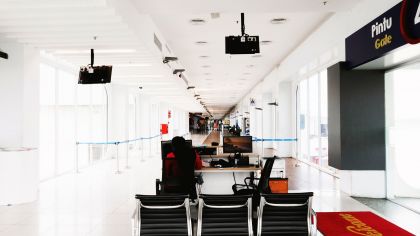Tips For Commercial Interior Decorating
21 September 2018
For most commercial properties it’s not possible or practical to take on full-scale refurbishments but there are a few small changes – a shift in the furniture layout, adding some wall art and creating a focal point - that can make all the difference without being too costly.

For many of us, a large portion of our days is spent at work. A well designed and lively commercial space can boost your creativity, whereas a dull and boring workspace can have the opposite effect.
Designing and decorating commercial properties can be a challenging experience; the space needs to be inviting for staff and visitors, reflect the culture of your business, and be efficient and cost-effective.
There are a few rules you can follow to do to make a difference without breaking the bank.
Arrangement of Furniture
Repositioning furniture can give your office a fresh perspective. In an era of increasing interaction and collaboration, commercial spaces are moving toward a more collaborative approach, changing their interior design layout to create more open workspaces.
Don’t:
- Place furniture across the whole floor.
- Push all your furniture up against the wall.
- Put all your furniture in one corner of the room.
Do:
- Place bookcases and filing cabinets close to your desk.
- To create the illusion of having a much larger space then you do keep as few things as possible away from the entryway and put desks and furniture into the centre of the room.
- If you’ve got your desk and bookshelf at one end of the room, try having a piece of art on the opposite wall to achieve some balance.
Wall Art
Canvas prints, framed photographs or an abstract piece of art has the ability to liven up an old and boring wall. The wonderful thing about wall art is it can be moved and changed as often as desired.
Don’t:
- Hang artwork too high.
Do:
- Hang artwork with the centre at eye level, or lower if viewed from a seated position.
- Select art appropriate for the setting; for example, word art might be ideal for a shared office space but it might not work in an office foyer, while an abstract and vibrant piece might complement a reception area but could be too much for the office kitchen.
Focal Points
Focal points can be used to draw attention to a defining feature or area and if done properly can make a room more inviting. Some rooms have built-in focal points like built-in shelving and other times you’ll have to create your own focal point using statement furniture, rugs, artwork or an accent wall.
Don’t:
- Have more than one focal point in any one room.
Do:
- If your focal point is an accent wall, it should be created on the furthest wall from the entry into the room. Select bold colours of patterned wallpaper.
- If you choose a statement piece of artwork or mirror, you’ll want to make sure it is big enough to suit the wall it is on. It should be placed at eye-level and ideally, you should add accent lighting to further highlight the piece.
- If your focal point is a large piece of furniture, be sure to add accents like a centrepiece for a table and pillows for a couch.
Lighting
No one wants to work in a dull and dark environment. Appropriate lighting can do wonders for commercial areas.
Don’t:
- Ignore the importance of task lighting.
- Use light bulbs that are too fluorescent or too yellow.
Do:
- Update wall fixtures and overhead lighting.
- Use a mix of task, ambient and accent lighting in every room.
- Make use of natural light.
- Use floor lamps and table lamps to add light to dark areas.
It's the little things
To revive the office, sometimes all you need to do is make a few small changes.
Don't:
- Overdo it.
Do:
- Spring clean, organise and declutter.
- Carefully think about paint colours.
- Add some quirky touches such as a feature wall with the company logo.
- Buy some houseplants.
- Throw down a rug.
We hope these tips have given you a starting point for turning your commercial property into a fun and vibrant workspace.